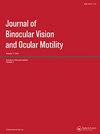Modified Nishida Procedure Combined with Lateral Rectus Disabling for Duane Retraction Syndrome
Q3 Medicine
Journal of Binocular Vision and Ocular Motility
Pub Date : 2023-04-20
DOI:10.1080/2576117X.2023.2197575
引用次数: 0
Abstract
ABSTRACT Duane retraction syndrome (DRS) is a complex congenital cranial dysinnervation disorder. The choice of surgical procedure in esotropic-DRS depends upon several factors that include: the amount of esotropia in the primary position, the presence and severity of palpebral fissure narrowing, globe retraction, presence of medial rectus muscle (MR) contracture, the likelihood of improving abduction, age of the patient, and the presence of binocularity and stereopsis. In the presence of MR contracture, MR recession is performed either alone (unilaterally or bilaterally) or in conjunction with Y splitting plus recession of the lateral rectus muscle (LR) for reducing globe retraction. MR recession, with or without adjustable sutures, may be simultaneously combined with partial thickness vertical rectus muscle transposition (VRT) or with superior rectus muscle transposition (SRT). We describe a novel combination of surgical procedures in the management of esotropic-DRS in two patients. In our first patient, following an initial MR recession combined with LR disinsertion and periosteal fixation (LRDAPF), a modified Nishida procedure was performed. In our second patient following a prior simultaneous MR recession and LR Y splitting with recession, we combined periosteal fixation of the LR with a modified Nishida procedure of the vertical rectus muscles.改良Nishida手术联合侧直肌失能治疗Duane回缩综合征
Duane回缩综合征(DRS)是一种复杂的先天性颅神经支配障碍。内斜视- drs的手术方式的选择取决于几个因素,包括:原发位置内斜视的程度、睑裂狭窄的存在和严重程度、睑球回缩、内侧直肌(MR)挛缩的存在、外展改善的可能性、患者的年龄、双眼和立体视的存在。在存在MR挛缩的情况下,MR收缩可以单独(单侧或双侧)进行,也可以与Y分裂加外直肌(LR)收缩一起进行,以减少全球收缩。有或没有可调节缝线的MR退行术可同时合并部分厚度垂直直肌转位(VRT)或上直肌转位(SRT)。我们描述了一种新颖的外科手术组合在管理内源性drs的两个病人。在我们的第一位患者中,在最初的MR衰退合并LR拔出和骨膜固定(LRDAPF)后,我们进行了改良的Nishida手术。在我们的第二例患者中,在先前同时进行MR后退和LR Y分裂并后退后,我们将LR骨膜固定与改良的垂直直肌Nishida手术相结合。
本文章由计算机程序翻译,如有差异,请以英文原文为准。
求助全文
约1分钟内获得全文
求助全文
来源期刊

Journal of Binocular Vision and Ocular Motility
Medicine-Ophthalmology
CiteScore
1.20
自引率
0.00%
发文量
42
 求助内容:
求助内容: 应助结果提醒方式:
应助结果提醒方式:


